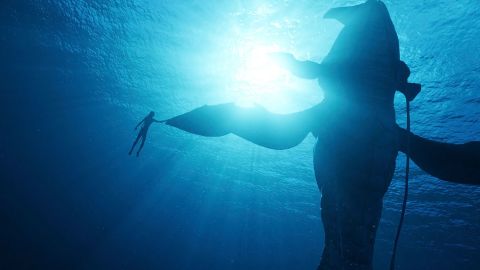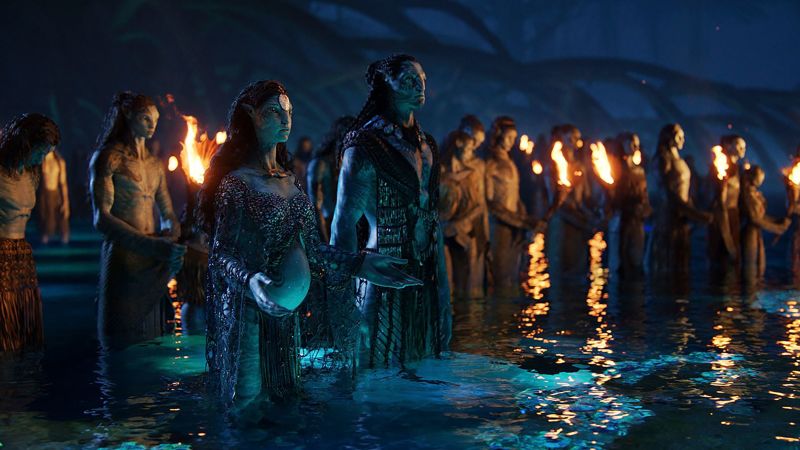CNN
—
More than a decade after sci-fi blockbuster “Avatar” hit theaters, James Cameron is back with a sequel that once again takes audiences into the lush world of Pandora. But some Indigenous viewers aren’t particularly interested in returning to it.
“Avatar: The Way of Water” and its director are facing fresh scrutiny from Native audiences, some of whom have criticized the franchise for its “White savior” narrative, use of stereotypes and inadequate representation of Indigenous people.
Yuè Begay, a Navajo artist and activist, called for a boycott of the film in a tweet that’s since received more than 47,000 likes, while Autumn Asher Blackdeer, a scholar from the Southern Cheyenne Nation, compiled a widely shared list of Indigenous-led sci-fi films for viewers to watch instead. Countless others have also weighed in with their own complaints, with some – including Begay – calling out remarks made by Cameron in earlier interviews.
The “Avatar” franchise isn’t subtle in its anti-colonial, anti-imperialist and environmentalist themes – Cameron has said as much, previously referring to the first film as “a science fiction retelling of the history of North and South America in the early colonial period.”
But despite the director’s intentions, critics of “Avatar” feel the films fall short in their execution.
The original 2009 film follows protagonist Jake Sully as he’s dispatched to the moon Pandora as part of an imperialist mission. There, he inhabits a new body that mimics the appearance of the Na’vi, the blue humanoid species indigenous to this new environment. As Sully bonds with the Na’vi and falls in love with princess Neytiri, he’s forced to choose between both worlds. In the sequel, Sully is now chief of the Omaticaya clan as he and his family once again come up against the colonial ambitions of the humans.
The decision to center Sully – whose race isn’t explicitly mentioned but whose outsider status is a clear parallel to White settlers – plays into the tired trope of the “White savior” and was a missed opportunity, said Crystal Echo-Hawk, president and CEO of IllumiNative.
“(Cameron) might be telling that story of colonization, but he’s telling it through the lens of a White male,” she told CNN.
By involving more Indigenous people at all levels of production, Echo-Hawk said Cameron might have been able to tell a more authentic story that would have resonated with audiences better.
“It’s a level of arrogance once again that a White filmmaker can just somehow tell a story that’s based on Indigenous peoples better than Indigenous peoples ever could,” she added.
She said her organization IllumiNative, which aims to improve media portrayals of Indigenous people, is in talks with Disney on how the “Avatar” franchise might avoid similar pitfalls in its third installment, set to release 2024.
“The Way of Water” does go a little deeper than its predecessor. It introduces the Metkayina people of the reef in a nod to the Māori, in an attempt to showcase the diversity of Indigenous peoples around the world. It also casts Cliff Curtis, who is of Māori descent, as Metkayina chief Tonowari. But many of the other characters are still voiced by White actors.
Adam Piron, a filmmaker and director of the Indigenous program at Sundance Institute, said he hasn’t yet seen the latest installment of the “Avatar” franchise, though he plans to. But he sees Cameron’s sci-fi epic as part of a long history of White filmmakers projecting their own ideas of Indigeneity onscreen, rather than involving Indigenous people themselves.
“All that’s left anymore with those films is the non-Indigenous desire to be Indigenous or to have some sort of connection to Indigenous people,” he added.

The films have also been accused of cultural appropriation for the way in which they bring together disparate elements of Indigenous cultures in their portrayal of the fictional Na’vi. While “The Way of Water” does draw inspiration from the Māori, Echo-Hawk said the film could have benefited from a deeper partnership.
“It’s based on what James Cameron’s notion is of what he thinks Indigenous history is, what he thinks Indigenous culture is,” she said. “Everyone thinks that we’re a monolith. What it does is flatten who Indigenous peoples are, what Indigenous cultures, language, practices are.”
Part of the outrage around the sequel has also stemmed from recently resurfaced comments that Cameron made in 2010 to The Guardian as he joined the Xingu people in the Amazon in their fight against a dam project. Witnessing Indigenous ceremonies in the Amazon, Cameron said, prompted him to consider the plight of Native peoples in North America.
“I felt like I was 130 years back in time watching what the Lakota Sioux might have been saying at a point when they were being pushed and they were being killed and they were being asked to displace and they were being given some form of compensation,” he said at the time. “This was a driving force for me in the writing of Avatar – I couldn’t help but think that if (the Lakota Sioux) had had a time-window and they could see the future… and they could see their kids committing suicide at the highest suicide rates in the nation… because they were hopeless and they were a dead-end society – which is what is happening now – they would have fought a lot harder.”
Cameron responded to criticism of “Avatar” earlier this month, telling British media site Unilad that “the important thing is to listen and to be sensitive to issues that people have.”
“It’s not up to me, speaking from a perspective of White privilege, if you will, to tell them that they’re wrong,” he said of his critics. “It has validity. It’s pointless for me to say, ‘Well, that was never my intention.’”
Rhonda Lucy, founder of the Toronto Indigenous Filmmakers Collective and the media production company Sun Raven Arts, said she doesn’t plan to see “The Way of Water.”
“I live that reality. My community lives this reality,” Lucy said. “Why would I want to pay the small amount of money I make to hand over to a massive money making machine to pay them to show me heartache and pain that’s just glazed over?”
But while she understands and shares in the criticism, she hopes that Indigenous creatives will take this as a sign to develop their own ambitious projects.
“We have a whole bunch of nerds in our community who love writing and creative writing and doing so much sci-fi,” she said. “I want to see our people leave all of this stuff in the dust, and say, ‘We made our own.’”
Sumber: www.cnn.com







